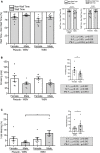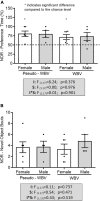Whole Body Vibration Improves Spatial Memory, Anxiety-Like Behavior, and Motor Performance in Aged Male and Female Rats
- PMID: 35126091
- PMCID: PMC8815031
- DOI: 10.3389/fnagi.2021.801828
Whole Body Vibration Improves Spatial Memory, Anxiety-Like Behavior, and Motor Performance in Aged Male and Female Rats
Abstract
Aging is a progressive process leading to functional decline in many domains. Recent studies have shown that physical exercise (PE) has a positive influence on the progression of age-related functional decline, including motor and brain functions. Whole body vibration (WBV) is a form of passive stimulation by mechanical vibration platforms, which offers an alternative for PE interventions, especially for aged individuals. WBV has been demonstrated to mimic the beneficial effects of PE on the musculoskeletal system, as well on the central nervous system. However, preclinical data with aged rodents are very limited. Hence, the purpose of this experiment was to investigate the effects of a 5-week WBV intervention with an aged animal model on memory functions, anxiety-related behavior, and motor performance. The 18-month old male (N = 14) and female (N = 14) Wistar rats were divided into two groups, namely, vibration and pseudo-vibration. Animals underwent a 5-week WBV intervention protocol with low intensity (frequency of 30 Hz and amplitude of 50-200 μm) stimulation. After 5 weeks, the following cognitive and motor tests were administered: open-field, novel and spatial object recognition, grip-hanging, and balance-beam. WBV-treated rats showed a decrease in their anxiety level in the open field test compared with those in the pseudo-treated controls. In addition, WBV-treated male animals showed significantly increased rearing in the open-field test compared to their pseudo controls. Spatial memory was significantly improved by WBV treatment, whereas WBV had no effect on object memory. Regarding motor performance, both grip strength and motor coordination were improved by WBV treatment. Our results indicate that WBV seems to have comparable beneficial effects on age-related emotional, cognitive, and motor decline as what has been reported for active PE. No striking differences were found between the sexes. As such, these findings further support the idea that WBV could be considered as a useful alternative for PE in case active PE cannot be performed due to physical or mental issues.
Keywords: healthy aging; muscle strength; object recognition; open field activity; passive physical exercise.
Copyright © 2022 Oroszi, Geerts, de Boer, Schoemaker, van der Zee and Nyakas.
Conflict of interest statement
The authors declare that the research was conducted in the absence of any commercial or financial relationships that could be construed as a potential conflict of interest.
Figures






References
LinkOut - more resources
Full Text Sources
Research Materials

